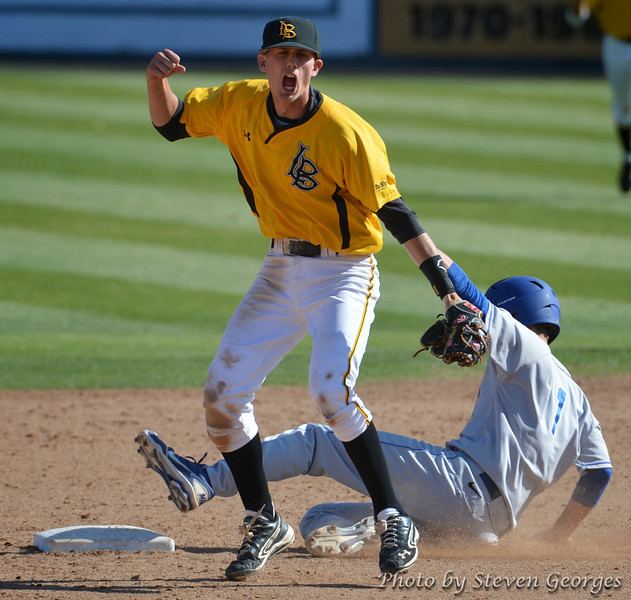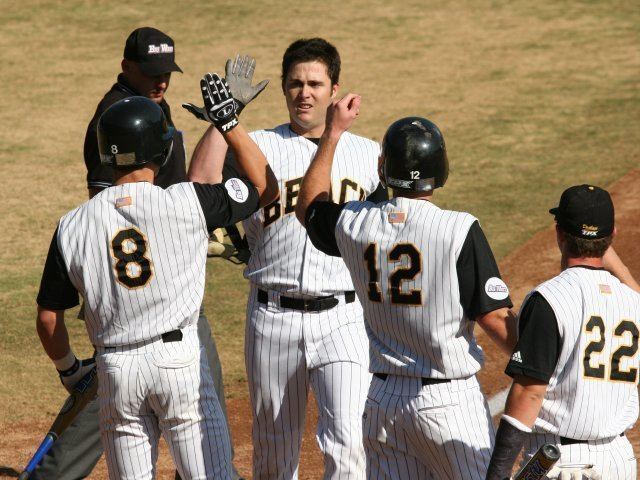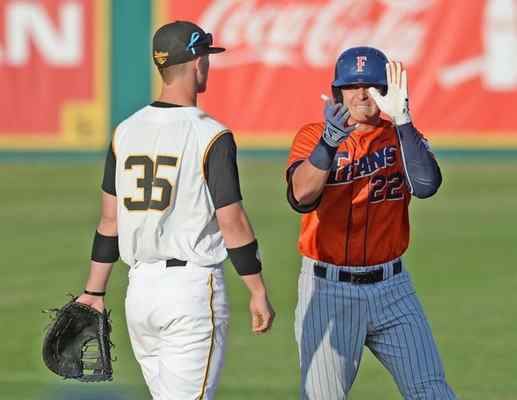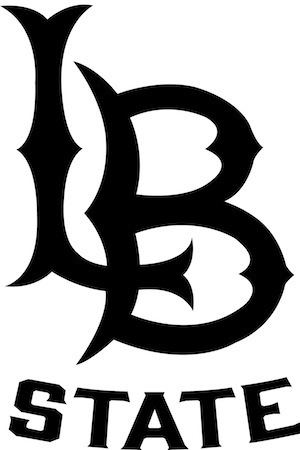Colors Black and Gold League Division I (NCAA) | Nickname Dirtbags Founded 1954 | |
 | ||
Home stadium Blair Field(Capacity: 3,342) | ||
Ncaa baseball long beach state dirtbags vs cal state fullerton big west conference
The Long Beach State 49ers baseball team is the college baseball program that represents California State University, Long Beach. Although all Long Beach State sports teams are officially known as the 49ers, the baseball team is generally referred to as the "Dirtbags". Their colors are black and gold.
Contents
- Ncaa baseball long beach state dirtbags vs cal state fullerton big west conference
- 195459 Formation the McConnell Era
- 196069 Belonging the Wuesthoff Era
- 197088 Breaking New Ground the Gonsalves Era
- 19892001 Enter the Dirtbags the Snow Era
- 200210 Validation the Weathers Era
- 2011present Maintaining the Identity the Buckley Era
- The Dirtbag Spirit
- References

Long Beach State (LBSU) has competed in the NCAA Division I Big West Conference (BWC) – originally known as the Pacific Coast Athletic Association (PCAA, from 1969 to 1988) – since the 1969–1970 academic year. Before becoming a founding member of the PCAA (now BWC), LBSU participated in the NCAA Division II California Collegiate Athletic Association (CCAA) from 1957 to 1969, and before that spent three years as an independent team.

The Long Beach State baseball team gained national prominence in 1989, with the hiring of Dave Snow as head coach. Since then The Dirtbags have been, historically, one of the strongest teams on the West Coast, being consistently ranked in the national top 25 and appearing in 17 of 20 NCAA tournaments through 2008.

The Dirtbags currently play their home games at Blair Field, a semi-professional baseball facility located less than 2 miles from campus and operated by the city of Long Beach.

1954–59: Formation, the McConnell Era

When John McConnell agreed to coach the first ever baseball team at the new Long Beach State College in 1954, he faced adversity almost from the start. For one thing McConnell was a cross country runner by trade, not a baseball player, and he was already splitting his time by also serving as an assistant coach for the basketball team. For another, the school had yet to build a baseball field of its own, so the team was forced to survive by holding practices on the public field at Whaley Park adjacent to campus. All of the team's first 11 games were played on the road; only towards the very end of the season, when the school's field was finally completed, could the 49ers host their first home game. On top of it all, the fledgling program faced by a severe lack of players: the entire roster consisted of just 14 players at the start of the year. In the end the team's unfortunate circumstances resulted in a lackluster performance, and a modest 3–13 record for the 1954 season.

Indeed, McConnell's task of producing a winning team seemed almost impossible. The program was handicapped by a minuscule operating budget of only about $3,000 (with no athletic scholarships), and the extremely limited roster forced McConnell to employ a 3-man pitching rotation. But McConnell stuck with the team, determined to make the most of the school's limited resources and produce a winning program. And in spite of conditions, the young 49ers managed to produce two outstanding seasons in 1955 and '56, with records of 17-4 and 18-6 respectively.
However, the young team's progress was put to the test in 1957 when Long Beach State was admitted into the NCAA's Division II. After three years of being an independent team, the greater level of competition in the CCAA conference caused the 49ers to struggle even to produce a winning record. At the end of the 1959 season, after grinding through three consecutive years of mediocrity and a 48–42 cumulative record in NCAA play, John McConnell stepped down as coach of the Long Beach State baseball team. But because of his impressive academic record (50 of his 57 players graduated), he stayed on as a staff member in the P.E. department for nearly 30 more years.
1960–69: Belonging, the Wuesthoff Era
Dick Clegg took over the program after McConnell's departure, and almost immediately he appeared capable of taking the 49ers to heights that his predecessor had been unable to. The team finished the 1960 season with a promising 20–14 overall record and a 9–6 mark in CCAA play for a third-place finish in the conference, and there seemed to be reason to hope that the future held even brighter things for the 49ers baseball program. But unfortunately Clegg was unable to reproduce the success of his first season with the club, and under his guidance the 49ers failed to garner another winning season. Clegg's teams accumulated a disappointing 32–65–1 record over the next three years, including an abysmal 6–25–1 record in 1963. This lack of production led to Clegg's dismissal following the 1963 season.
True success came when the program handed the reins to former freshman junior varsity coach, and assistant basketball coach Bob Wuesthoff in 1964. In Wuesthoff's first year as head coach, the 49ers rebounded impressively from the previous year's meltdown by going 31-13, earning the program's first conference championship and first entry into the NCAA National Tournament and setting a school record for wins that would stand until 1979 (The .704 winning percentage wouldn't be topped until 1989). This time, the first-year optimism did not give way to letdown.
Under Wuesthoff, the 49ers finished with a winning record in each of his six years as skipper at Long Beach State, accumulated a 161–101–4 (.613) overall record, and only once finished worse than third in the conference. By the time the 49ers won their second CCAA title in 1969, Wuesthoff was already the most successful coach in Long Beach State's short sports history. But changes came to the school in 1970, when Long Beach State was admitted to the NCAA's Division I. One of those changes came when Wuesthoff announced that he would not return for the 1970 season.
1970–88: Breaking New Ground, the Gonsalves Era
The 1970 season not only marked LBSU's first foray into Division 1, it also marked the first hiring of a team alumni as head coach. Incoming skipper John Gonsalves had played second base for the team from 1964–65, and even earned NCAA all-district honors his senior year. After a mildly distinguished 3-year career in the New York Mets minor league system (netting one selection to the class A New York - Penn League all-star team), Gonsalves returned to his alma mater to take over the reins from his former coach Bob Wuesthoff who was retiring.
In his first year, Gonsalves led the team to an uninspiring 29–23 overall record, but the team's 11-4 record in conference play was enough to capture the first ever conference title of the newly formed Pacific Coast Athletic Association (PCAA). That season also saw Gonsalves receive the inaugural PCAA Coach of the Year award. Gonsalves would remain at the helm of the program for the next 19 seasons, and through two conference changes. The first switch came in 1977, when Long Beach State joined the upstart Southern California Baseball Association (SCBA), an NCAA Division 1 baseball-only conference consisting of baseball teams from schools that otherwise competed in either the PCAA or the WCC.
The 49ers posted their best year to date in 1979, when the 49ers compiled a 40-22-3 mark that set a new school record for wins and was good enough for a second-place finish in the competitive SCBA. Unfortunately for the Gonsalves, he would never again coach a team to that level of success. Over the next 5 seasons, the 49ers only once posted a winning record or finished better than 4th in the conference. Even the demise of the SCBA and the renewal of PCAA competition (now known as the Big West) in 1985 couldn't change the fortunes of the hard luck 49ers, as they placed seventh in the conference in '85 and eighth in each of the next three years. This unfortunate stretch of underachievement left the Long Beach State baseball program disappointed and disillusioned. Despite holding the school career wins record at the time by a considerable margin, Gonsalves managed only a 205–342–10 cumulative record over his last 9 years. After the 1988 season, Gonsalves stepped down as head coach.
1989–2001: Enter the Dirtbags, the Snow Era
When Dave Snow arrived at Long Beach in 1989, after a successful 4-year run at Loyola Marymount where he led the Lions to 2 WCC titles and their first ever CWS appearance, he found himself inheriting a program in disarray. The 49ers had compiled a horrific 14–45 record the year before, and the roster consisted almost entirely of new players. What's more, the 49ers were still being forced to play without the benefit a true home field (instead splitting games between Long Beach City College, Cerritos College, and Blair Field). Undaunted, Snow set to work rebuilding the program, and wound up engineering one of the greatest single-season turnarounds in NCAA history.
The lack of a field ended up being a crucial ingredient in the creation of the team's iconic nickname. Over the course of the season, infield coach Dave Malpass would routinely take his players to a local (all-dirt) Pony League field for practices, while the rest of the team stayed at the on-campus practice field. When the infielders rejoined the team, their uniforms caked with dirt, the other coaches would tease Malpass about his group of “Dirtbags.”
Long Beach State exploded onto the college baseball scene in 1989, winning their first 18 games right out of the starting gate. Just one year removed from their embarrassing 14-45 flop of a season, the reborn 49ers performed an almost unbelievable turnaround by posting an impressive 50-15 overall record and winning their first conference title in two decades. In their first ever NCAA Tournament appearance, the "Dirtbags" quickly became fan favorites for their gritty and spirited character as they fought their way to a Regional victory and reached the College World Series, another school first. Though they failed to win a game in the Series, the Dirtbags' improbable run earned Snow NCAA Coach of the Year honors.
The team suffered a mild regression in 1990, slipping to 4th in the conference and missing the postseason. But the following year Snow and the Dirtbags hit their stride, and set about proving that they were not a one-hit wonder. In 1991 Snow led his team to a very respectable 46–19 record, good for a 2nd-place finish in the conference and an at large bid to the NCAA tournament. In just the second postseason appearance in school history, the team again won their regional and advanced to their second College World Series, this time reaching the 2nd round before being eliminated. From 1992-'94 the Dirtbags elevated their game even further by winning 3 consecutive Big West titles and reaching the College World Series yet again in '93, making it 3 CWS berths in 5 years.
In fact, 1993 was arguably the Dirtbags' finest season (perhaps even more so than the iconic 1989 season), as the Dirtbags advanced farther in a postseason than ever before: a mere 3 outs from a berth in the National Championship Game. After capturing the Big West Title and earning a top 10 ranking in all the major polls, the Dirtbags swept through their regional with four straight wins. In the College World Series, the Dirtbags eliminated Kansas and Texas A&M en route to a semifinal matchup with the LSU Tigers. LBSU and LSU each held one victory going into the rubber match of the series, and the Dirtbags played their way to a 5-3 lead going into the bottom of the ninth inning. But the Tigers used their final at-bats to mount a dramatic 3-run rally, eliminating the Dirtbags in heartbreaking fashion. The Tigers went on to dominate the National Championship Game, beating Wichita State 8–0 for their second national title.
Despite falling short of the national championship, the Dirtbags continued to play at a consistently high level in the Big West. As it turns out, an unexpected side effect of The Dirtbags' newfound success was the triggering of a regional rivalry between LBSU and established baseball powerhouse Cal State Fullerton. The two Cal States proceeded to dominate Southern California baseball: during Snow's 13-year tenure, the Dirtbags and the Titans won 12 of 13 Big West Championships (1 shared) and combined for 22 NCAA Tournament appearances and 10 College World Series berths. (By way of comparison, traditional SoCal athletic powerhouses USC and UCLA combined for only 19 Tournament appearances and 6 CWS berths over the same period.) The Long Beach-Fullerton rivalry remains). Long Beach State reached their last College World Series in 1998 primarily on the arm of lefty Mike Gallo who shut out host Cal State Fullerton in a complete game, (12–0) in the Big West tournament and the following week, went the distance, to stun host Stanford 5–1 in Palo Alto and then the Dirtbags eliminated Alabama the next day to reach the CWS. Chuck Lopez and Russ Day provided the bulk of the offence during the year.
Snow retired following the 2001 season after compiling a career record at LBSU of 511-290-4 (.638 winning percentage), 6 Big West championships, 11 NCAA Tournament appearances, and 4 College World Series berths, including 3rd-place finishes in 1993 and '98. Snow still holds the LBSU career coaching records in all the aforementioned categories. Snow also received more Big West Coach of the Year accolades (5) than any other coach in program history, and remains the only coach to be named NCAA Coach of the Year (1989).
2002–10: Validation, the Weathers Era
Dave Snow’s powerful legacy remained with the Dirtbags program even after his retirement. Immediately after Snow’s departure, LBSU athletic director Bill Shumard confirmed that Snow’s longtime assistant Mike Weathers would take over as head coach. Weathers, who had known Snow since the pair’s playing days at Cerritos College in the late ‘60s, had previously served as head coach at Utah and Chapman College before spending the last 9 seasons working under Snow at LBSU. Having served as associate head coach the year before, the veteran Weathers sought to utilize his vast coaching experience to maintain the level of success that Snow had established before him.
Weathers did not disappoint. In his first year after taking the reins from Snow, the Dirtbags didn’t skip a beat as they cruised to a 39–21 overall record and an at-large bid to the NCAA Tournament. This turned out to be the first of an impressive 7-year run for the team, where from 2002–08 the Dirtbags never finished worse than 2nd in the conference and only once ended with fewer than 37 wins. 6 of those 7 seasons also saw the Dirtbags earn a berth in the NCAA Tournament.
Perhaps most impressive about Weather’s tenure was the amount of major league talent produced by him and his coaching staff. Despite the fact that LBSU by now commanded a respectable baseball reputation, the limited budget afforded to the state-funded school often forced the Dirtbags staff to focus on recruiting and developing prospects that were overlooked by other schools. One such case was Jered Weaver, who was dismissed by many scouts on the belief that he was more cut out for basketball than baseball. But Weaver went on to have a fine career as a Dirtbag, and his 2004 junior season became the most decorated for a single player in school history, netting him his second consecutive first team All-America selection while also winning (among other honors) the Dick Howser Trophy, the Roger Clemens Award, and the Golden Spikes Award.
An even more dramatic example of prospect development was Evan Longoria, who (being widely regarded as too scrawny to compete for a Division 1 program) received no scholarship offers at all out of high school. Undeterred, Longoria enrolled at Rio Hondo Community College and played for one season, after which he was finally offered a scholarship at Long Beach State. Longoria would spend the next two seasons as the starting third baseman for the Dirtbags, and by the end of his junior year at LBSU, diligent hard work and expert instruction had transformed him into an imposing physical specimen who was described by various media outlets as the "top position player" and "best pure hitter" available in the 2006 draft. That year Longoria became the highest-drafted player in school history (3rd overall), which also marked the third straight year that Long Beach State had a player selected in the first round of the draft (Weaver went 12th in 2004, and Troy Tulowitzki 7th in 2005).
The main downfall with Weathers is he never did well in the regional's nor reach the College World Series even tho he had players like Jared Weaver,Evan Longoria and Troy Tulowwitzki.
Predictably, the rivalry between the Dirtbags and the Cal State Fullerton Titans continued as heated as ever under Weathers; the annual season-ending series between the two teams more often than not decided the conference championship. From 2002-’08, the two rivals flexed their muscle in the Big West by combining to win 6 more conference titles (1 shared). In fact in the 20 seasons from 1989-2008, 17 ended with either the Dirtbags or the Titans being crowned Big West champions.
Unfortunately, immediately after capturing the 2008 Big West title, the Dirtbags saw the conference power balance tip decidedly against them. It started in the offseason, when LBSU lost 11 players to the 2008 draft, making it the largest draft class in school history and one that featured several star players, including All-Americans Shane Peterson and Andrew Liebel. Ultimately the Dirtbags proved unable to compensate for such a mass exodus of talent, and they fell into a major slump as they skidded to a 25-29 overall record in 2009, their first losing record in over two decades. The team’s funk deepened in 2010 as they finished 23-32, dead last in the Big West for the first time in 22 years. Perhaps even more embarrassing was the fact the Dirtbags lost each of their 7 meetings with the arch-rival Titans over that two-year span.
On May 11, 2010 (two weeks before the close of the season), Weathers announced that he would be retiring at season’s end. “There needed to be a change and new energy in the program, because it hasn't been going great the last couple years,” Weathers said. “I've been doing this for 32 years, and so it's time. It can give somebody else a chance, and there's no hard feelings.” Weathers was remembered by CSULB President F. King Alexander as "an outstanding leader of the program and a great representative of the university." Weathers left LBSU with the second most conference championships and postseason appearances to his name, as well as the second-highest winning percentage in school history (all behind his predecessor and mentor Dave Snow). Weathers also had coached the most Big West Players/Pitchers of the Year (6) and the most future MLB draft picks (56) of any coach in school history at the time of his retirement.
Following Weathers’s retirement announcement, the Dirtbags lost 9 of their last 10 games in 2010.
2011–present: Maintaining the Identity, the Buckley Era
On June 1, 2011, two days after the close of the 2010 season, athletic director Vic Cegles held a press conference to formally introduce associate head coach Troy Buckley as LBSU’s 7th head coach. A former professional player himself, Buckley first joined the Dirtbags' program as an assistant head coach in 2001, Dave Snows's final year as head coach; once again Snow's powerful legacy continued to (indirectly) influence the program's direction. Buckley served until 2007 as pitching coach, during which time he tutored numerous future Major Leaguers including Abe Alvarez, Jason Vargas and 2004 National Player of the Year Jered Weaver. Buckley's tremendous success in developing pitching talent led the Pittsburgh Pirates to seek his services, offering him a position as pitching coordinator for the Pirates' entire minor league system.
After two years in the Pirates' system, Buckley returned to LBSU in 2010 to take the position of associate head coach. Following Mike Weathers's retirement and his own promotion, Buckley promised to carry on the Dirtbag tradition. "We’re still going to play a gritty type of baseball and hopefully show our fans that these guys don’t quit. They fight and they grind and they get knocked down, but they keep coming back. We want to be fundamentally sound and not beat ourselves. We want to do things the right way." But while speaking highly of the program's legacy of fundamentally-sound baseball, Buckley also shared Weathers's growing concern that the team's recent history of producing highly regarded MLB talent had been causing the team to lose sight of that legacy. "We just have to make sure these guys that are coming here are doing it for the right reasons. Not just to get to the big leagues or be a first-round draft choice."
Buckley's first season as skipper was far from overwhelming, as the team finished with a paltry but promising 29–27 overall record. This marked the first time in 3 seasons that the Dirtbags finished over .500, and also saw the team climb from 9th place back into 4th in the Big West with a conference record of 12–12.
Although 2012 saw little change in the team's overall record, the team's quality of play nonetheless showed marked improvement. The Dirtbags' record was a deceptive 8–15 at the end of April (10 of their losses had come by only one run, and 8 were decided in the 9th or extra innings), but they proved more than capable in conference play, winning all but 2 of their head-to-head series. In fact, heading into the final weekend of the season, the Dirtbags found themselves only 1 game behind Fullerton, with the final 3-game series between the two rivals set to determine the Big West title. Fullerton eventually took two of the three games, clinching the Titans' 3rd straight conference championship. (Cal Poly's 7-game winning streak to close the season allowed the Mustangs to finish 2nd in the Big West ahead of LBSU.)
The Dirtbag Spirit
Although the baseball team – like all other LBSU sports teams – is officially known as the 49ers, the baseball team's players and fans alike generally prefer the more colloquial name the "Dirtbags." This ironic handle is a great source of pride and shared identity for the program, in no small part because it is frequently misinterpreted by outsiders as being a disparagement. In fact, various media outlets have highlighted the program's moniker as particularly undesirable. But despite the misunderstandings, the term "Dirtbag" is in fact distinct from truly pejorative demonyms that have been adopted later as symbols of pride (such as Limey and Hoosier). The term was instead coined as a badge of honor, referring to the team's scrappy playing style and success against higher profile programs.
The term first appeared in 1989, the first year under head coach Dave Snow. Snow took a program that finished 14-45 the year before and turned it into a national title contender, posting a 50–15 record and reaching the College World Series for the first time in school history. Remarkably, Snow accomplished all this without the benefit of a generous athletics budget, an experienced roster or even a home field, thus embodying the Dirtbag spirit. More than 20 years later, the Dirtbag name continues to be worn with distinction, by players both old and new.
